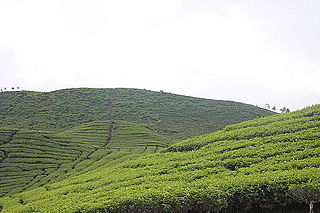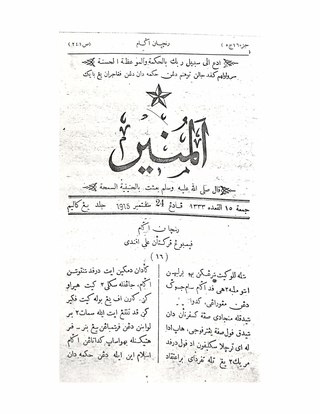
Sumatra is one of the Sunda Islands of western Indonesia. It is the largest island that is fully within Indonesian territory, as well as the sixth-largest island in the world at 475,807.63 km2 (182,812 mi.2), including adjacent islands such as the Simeulue, Nias, Mentawai, Enggano, Riau Islands, Bangka Belitung and Krakatoa archipelago.

Minangkabau people, also known as Minang, are an Austronesian ethnic group native to the Minangkabau Highlands of West Sumatra, Indonesia. The Minangkabau's West Sumatera homelands was the seat of the Pagaruyung Kingdom, believed by early historians to have been the cradle of the Malay race, and the location of the Padri War.

Riau is a province of Indonesia. It is located on the central eastern coast of Sumatra along the Strait of Malacca. The province shares land borders with North Sumatra to the northwest, West Sumatra to the west, and Jambi to the south, and a maritime border with the Riau Islands and the country of Malaysia to the east. It is the second-largest province in the island of Sumatra after South Sumatra, and is slightly larger than Jordan. According to the 2020 census, Riau had a population of 6,394,087 across a land area of 89,935.90 km²; the official estimate of population as of mid-2022 was 6,614,384. The province comprises ten regencies and two cities, with Pekanbaru serving as the capital and largest city.

Minangkabau is an Austronesian language spoken by the Minangkabau of West Sumatra, the western part of Riau, South Aceh Regency, the northern part of Bengkulu and Jambi, also in several cities throughout Indonesia by migrated Minangkabau. The language is also a lingua franca along the western coastal region of the province of North Sumatra, and is even used in parts of Aceh, where the language is called Aneuk Jamee.

West Sumatra is a province of Indonesia. It is on the west coast of the island of Sumatra and includes the Mentawai Islands off that coast. West Sumatra borders the Indian Ocean to the west, as well as the provinces of North Sumatra to the north, Riau to the northeast, Jambi to the southeast, and Bengkulu to the south. The province has an area of 42,119.54 km2 (16,262.45 sq mi), with a population of 5,534,472 at the 2020 census. The official estimate at mid 2022 was 5,640,629. The province is subdivided into twelve regencies and seven cities. It has relatively more cities than other provinces outside Java, although several of them are relatively low in population compared with cities elsewhere in Indonesia. Padang is the province's capital and largest city.

Payakumbuh is the second largest city in West Sumatra province, Indonesia, with a population of 116,825 at the 2010 Census and 139,576 at the 2020 Census; the official estimate as at mid 2022 was 143,325 - comprising 72,186 males and 71,139 females. It covers an area of 80.42 km² and is in the Minangkabau Highlands, 120 km by road from the West Sumatran capital city of Padang and 180 km from the Riau capital city of Pekanbaru.

Pencak silat is an umbrella term for a class of related Indonesian martial arts. In neighbouring countries, the term usually refers to professional competitive silat. It is a full-body fighting form incorporating strikes, grappling, and throwing, in addition to weaponry. Every part of the body is used and subject to attack. Pencak silat was practiced not only for physical defense but also for psychological ends. There are hundreds of different pencak silat styles and schools which tend to focus either on strikes, joint manipulation, weaponry, or some combination thereof.

Rumah Gadang or Rumah Bagonjong "house for the Minangkabau people" are the traditional homes of the Minangkabau in West Sumatra, Indonesia. The architecture, construction, internal and external decoration, and the functions of the house reflect the culture and values of the Minangkabau. A Rumah Gadang serves as a residence, a hall for family meetings, and for ceremonial activities. In the matrilineal Minangkabau society, the Rumah Gadang is owned by the women of the family who live there; ownership is passed from mother to daughter.

Pagaruyung, also known as Pagarruyung, Pagar Ruyung and, Malayapura or Malayupura, was a kingdom that once stood in the island of Sumatra and the seat of the Minangkabau kings of Western Sumatra. Modern Pagaruyung is a village in Tanjung Emas subdistrict, Tanah Datar regency, located near the town of Batusangkar, Indonesia.

The Mandailing are an ethnic group in Sumatra, Indonesia that is commonly associated with the Batak people. They are found mainly in the northern section of the island of Sumatra in Indonesia. They came under the influence of the Kaum Padri who ruled the Minangkabau of Tanah Datar. As a result, the Mandailing were influenced by Muslim culture and converted to Islam. There are also a group of Mandailing in Malaysia, especially in the states of Selangor and Perak. They are closely related to the Angkola and Toba.

The Overseas Minangkabau is a demographic group of Minangkabau people of Minangkabau Highlands origin in Central Sumatra, Indonesia who have settled in other parts of the world. Over half of the Minangkabau people can be considered overseas Minangkabaus. They make up the majority of the population of Negeri Sembilan and Pekanbaru. They also form a significant minority in the populations of Jakarta, Bandung, Medan, Batam, Surabaya and Palembang in Indonesia as well as Kuala Lumpur, Malacca, Penang, Singapore and Brunei Darussalam in the rest of the Malay world. Minangkabaus have also emigrated as skilled professionals and merchants to the Netherlands, United States, Saudi Arabia and Australia. The matrilineal culture and economic conditions in West Sumatra have made the Minangkabau people one of the most mobile ethnic group in Maritime Southeast Asia.
Minangkabau businesspeople refers to merchants from the Minangkabau Highlands in central Sumatra, Indonesia. Minangkabau are the ethnic majority in West Sumatra and Negeri Sembilan. Minangkabau are also a recognised minority in other parts of Indonesia as well as Malaysia, Singapore and the Netherlands.

Alahan Panjang is a village in the kecamatan of Lembah Gumanti, Solok, West Sumatra, Indonesia. The village is located on Kerinci Seblat National Park's eastern slopes, at an altitude of 1,400–1,600 metres (4,600–5,200 ft), near Mount Talang. Situated between Alahan Panjang and the other nearby major town of Muara Labuh are the subvillages of Air Dingin Barat, Alang Laweh, and Sungai Kalau II.

Asam pedas is a Maritime Southeast Asian sour and spicy fish stew dish. Asam pedas is believed to come from Minangkabau cuisine of West Sumatra, Indonesia and has spread throughout to the islands of Sumatra, Borneo and Malay Peninsula.

The Indonesian Malaysians are Malaysian citizens of Indonesian ancestry. Today, there are many Malaysian Malays who have lineage from the Indonesian archipelago and have played an important role in the history and contributed to the development of Malaysia, they have been assimilated with other Malay communities and are grouped as part of the foreign Malays or anak dagang in terms of race. The Malaysian census does not categorize ethnic groups from the Indonesian archipelago as a separate ethnic group, but rather as Malay or Bumiputera.

Islam is the most common religion in the Indonesian province of West Sumatra, embraced by 97.42% of the population. The Muslim population increases to 99.6% if it excludes the Mentawai Islands, where the majority of the non-Muslim (Protestant) West Sumatrans reside. Islam in West Sumatra is predominantly Sunni, though there is a small Shia Islamic pocket within the coastal city of Pariaman. The Minangkabau people, indigenous to West Sumatra, comprise 88% of the West Sumatran population today and have historically played an important role within Indonesia's Muslim community. Up until today, the region is considered one of the strongholds of Islam in Indonesia.

Al-Munir was an Islamic magazine, written in Arabic-Malay, published in Padang from 1911 until 1915. Inaugurated by the initiative of Abdullah Ahmad in early April 1911, Al-Munir was listed as the first Islamic mass media in Indonesia. The magazine was often associated with Al-Imam magazine published under the direction of Sheikh Tahir Jalaluddin in Singapore during 1906-1909. In addition to Abdullah Ahmad, several religious figures such as Abdul Karim Amrullah, Muhammad Thaib Umar and Sutan Muhammad Salim were recorded in the ranks of the editorial board.

Minangkabau culture is the culture of the Minangkabau ethnic group in Indonesia, part of the Indonesian culture. This culture is one of the two major cultures in the Indonesian archipelago which is very prominent and influential.

Music of Minang is a traditional and living genre of Indonesian music that grows and develops in the Minangkabau culture area. Music whose origins are related to Malay Music is generally played by musical instruments such as Talempong, Saluang, Minang rebab, Serunai, Tmbourine, Aguang, Gandang, and Violin. Minang music is also played to accompany various dances such as the Pasambahan dance and the Piring dance.

The Minangkabau Malaysians are citizens of the Malaysia whose ancestral roots are from Minangkabau of central Sumatra. This includes people born in the Malaysia who are of Minangkabau origin as well as Minangkabau who have migrated to Malaysia. Today, Minangkabau comprise about 989,000 people in Malaysia, and Malaysian law considers most of them to be Malays. They are majority in urban areas, which has traditionally had the highest education and a strong entrepreneurial spirit. The history of the Minangkabau migration to Malay peninsula has been recorded to have lasted a very long time. When the means of transportation were still using the ships by down the rivers and crossing the strait, many Minang people migrated to various regions such as Negeri Sembilan, Malacca, Penang, Kedah, Perak, and Pahang. Some scholars noted that the arrival of the Minangkabau to the Malay Peninsula occurred in the 12th century. This ethnic group moved in to peninsula at the height of the Sultanate of Malacca, and maintains the Adat Perpatih of matrilineal kinships system in Negeri Sembilan and north Malacca.



















